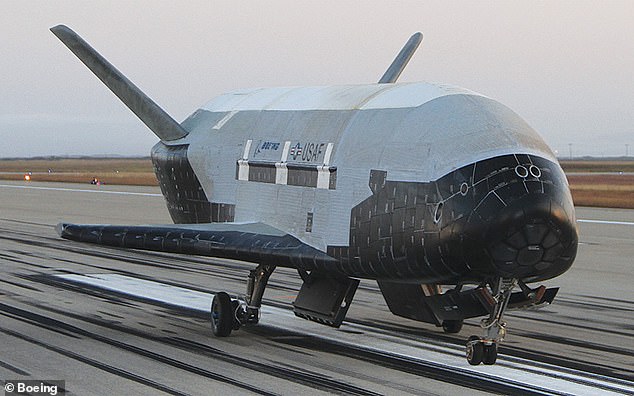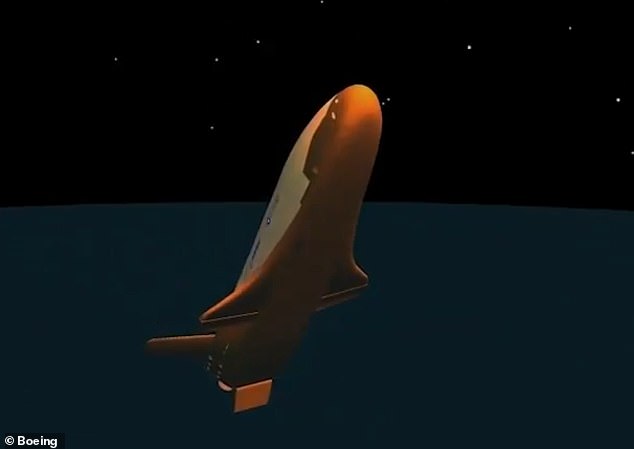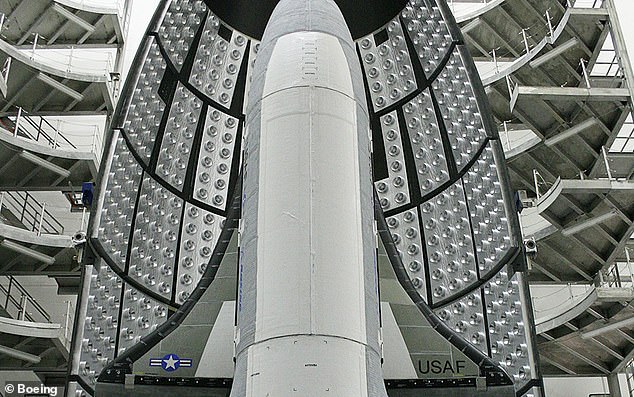Watch Space Force’s top secret spaceplane perform ‘groundbreaking’ orbital maneuver
The Pentagon has been closely monitoring details about the Space Force’s secret spaceplane, which continuously flies 500 miles above the Earth’s surface.
But the Department of Defense (DoD) has released a rare video showing the Boeing-built X-37B spacecraft performing a ‘game-changing’ maneuver to reach a new orbit level using a unique ‘aerobraking’ procedure .
The video shows the $200 million spacecraft pointing its flat underside forward, using friction from Earth’s atmosphere to slow down, treating it like a brake, while pointing the plane’s nose away from Earth.
Boeing engineer John Ealy said: ‘When we aerobrake, we use atmospheric drag to effectively lower our apogee step by step until we reach the orbital regime we want to be in.
“If we do this, we save enormous amounts of propellant, and that’s really why aerobraking is important.”
About the size of a small bus and resembling a miniature space shuttle, the X-37B launched on its seventh mission on December 29, 2023 and is currently still conducting experiments for NASA before returning to Earth.
Space Force has released a video showing the X-37B spacecraft’s “groundbreaking” maneuver

The X-37B aircraft is the first of its kind to use Earth’s atmosphere to reach a new level of orbit using an aerobraking procedure that relies on friction to slow it down
Space Force has not released information about the spacecraft’s main function, but has said it will conduct experiments with “space domain awareness technologies.”
This could mean that the new technology will be used to monitor other space traffic and observe what other spacecraft are doing.
The seventh mission marks the first time Boeing has attempted the aerobraking maneuver.
Aerobraking is a method of slowing a spacecraft by using a planet’s atmosphere, or outer layers of gas.
The spaceplane “dives” into the atmosphere, and as it does so, the gas molecules in the atmosphere rub against the ship.
This acts as drag and slows the ship down.
Often a ship will use aerobraking to change an orbit or slow a ship enough that gravity will pull it toward a planet.
The recent achievement followed previous missions aimed at safely flying the aircraft.
“This unique maneuver by the of space operations mentioned in a statement last month.
It is designed with a dual purpose: to land like an airplane on a runway, while the service module at the back carries additional payloads, although Boeing has not specified what those will be.

The spacecraft pointed its nose away from Earth as the friction heated the underside, causing the bottom to glow orange and slowing the vehicle.
“Once the aerobrake maneuver is complete, the the Space Force. .
The seventh mission first launched atop a SpaceX Falcon Heavy rocket, taking it to an unknown altitude.
According to the Space Force, it collects data for future manned missions by exposing plant seeds to the harsh radioactive environment of space.
The uncrewed
It has the capability to fly missions lasting up to 270 days to “support long-term space objectives,” Boeing said.

The X-37B spacecraft was launched in December aboard a SpaceX Falcon Heavy rocket
Holly Murphy, program director of Boeing’s Experimental Systems Group, said in the video, “X-37B missions have continually advanced our nation’s space capabilities by testing new technologies that reduce risk and inform our future space architectures. Mission seven is no different.”
Space Force’s X-37B has spent about 10 months in orbit so far, but the agency has yet to reveal when its seventh mission will end.
However, the aerobraking maneuver that brings it closer to Earth could indicate that it will return soon.
The video comes as China tests its own spaceplane, called Shenlong, which recently spent 268 days in orbit and completed its third mission on September 6.
China is the only other country in the world to have reusable spacecraft and has expressed concern that these aircraft will be used to launch microsatellites that could have military applications, the report said. Chinese Morning Star.
